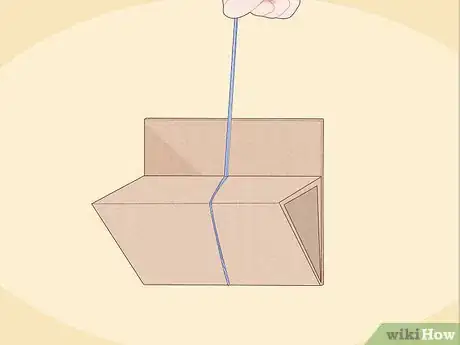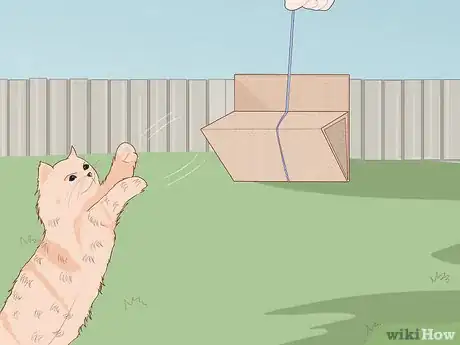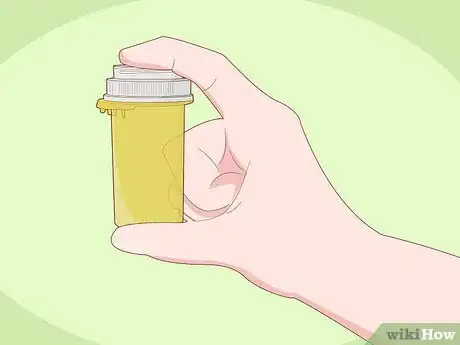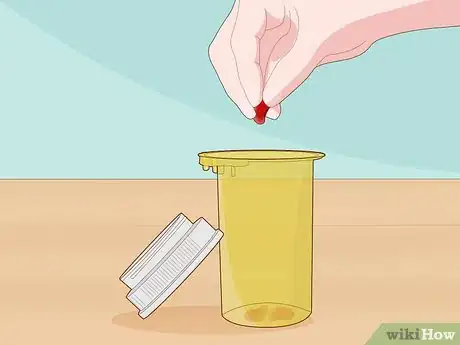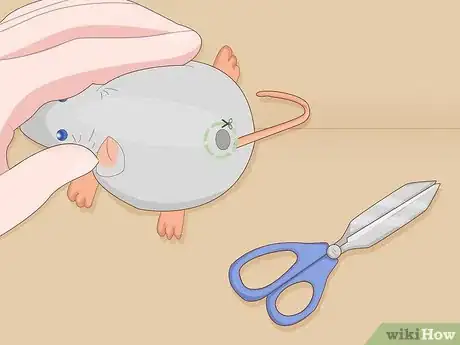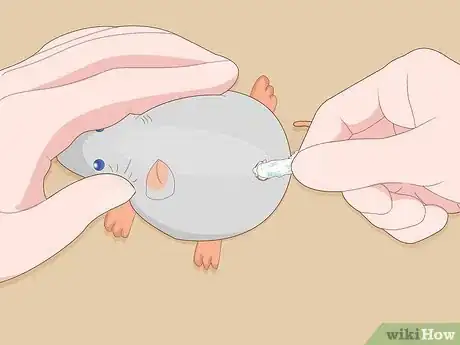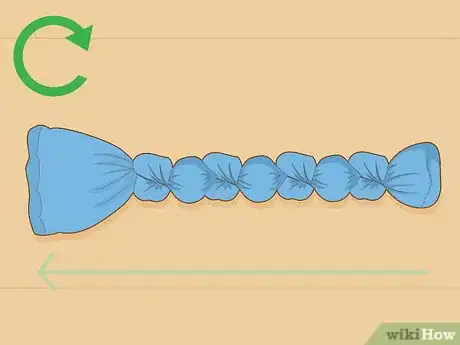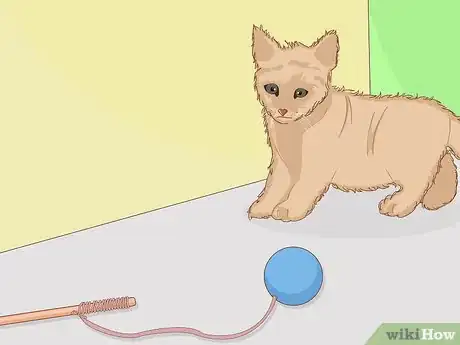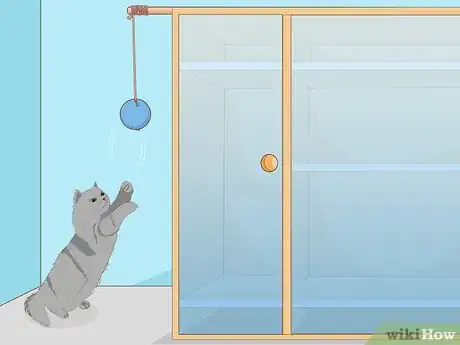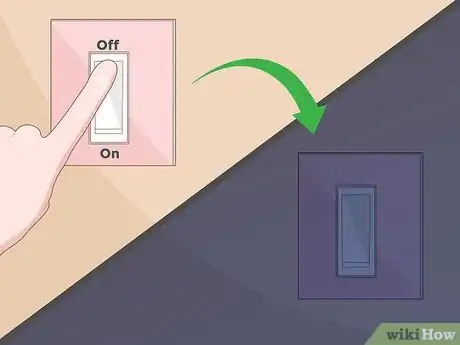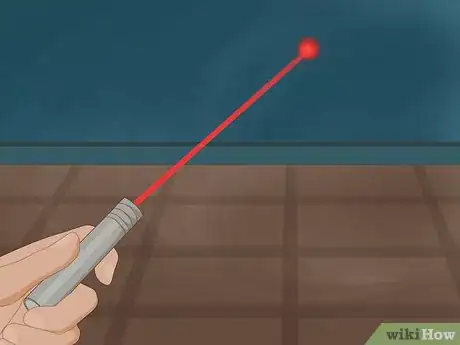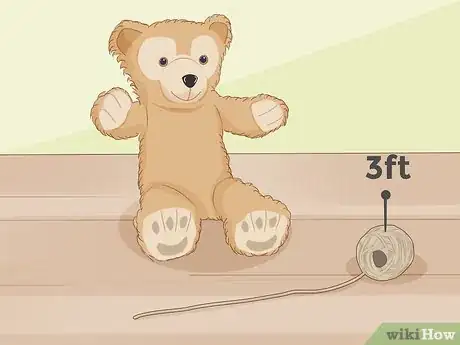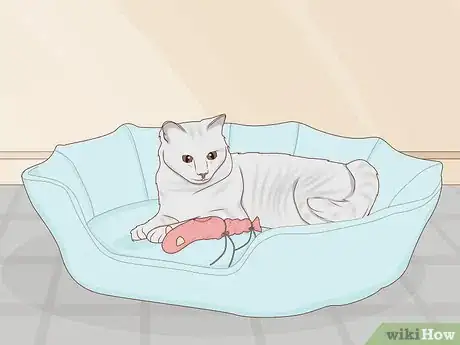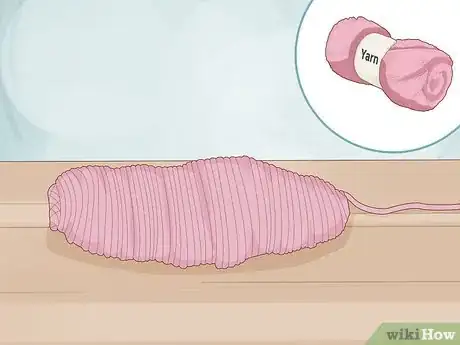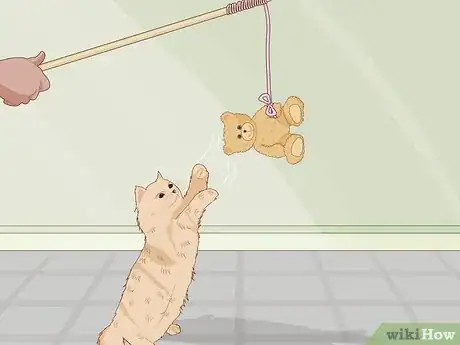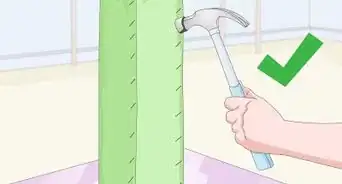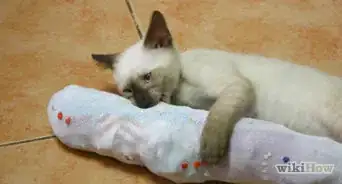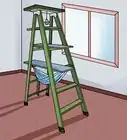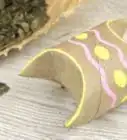This article was co-authored by Pippa Elliott, MRCVS. Dr. Elliott, BVMS, MRCVS is a veterinarian with over 30 years of experience in veterinary surgery and companion animal practice. She graduated from the University of Glasgow in 1987 with a degree in veterinary medicine and surgery. She has worked at the same animal clinic in her hometown for over 20 years.
There are 14 references cited in this article, which can be found at the bottom of the page.
wikiHow marks an article as reader-approved once it receives enough positive feedback. In this case, 85% of readers who voted found the article helpful, earning it our reader-approved status.
This article has been viewed 211,467 times.
Cats need toys for exercise and recreation. The best types of cat toys should mimic skills that your cat would need to employ if it were living in the wild.[1] Not all cats like playing with toys, and some will only like one type of toy. It can be expensive finding out what your cat likes. Colorful, shiny cat toys from the pet shop aren’t necessary, and often aren’t very good from the cat’s point of view. Making your cat's toys at home can save you money and allow you to bond with your pet.
Steps
Making a Cat Pendulum
-
1Cut a piece of cardboard into a rectangular shape. As an alternative, you can simply use an empty cardboard tube from a roll of toilet paper.
-
2Fold the cardboard over and poke the end of the string through it. Thread the string so that you will be able to dangle the cardboard securely from the end. The toy should begin to look like a pendulum that you will swing in front of your cat.Advertisement
-
3Draw the cardboard up the string a bit and fold over the bottom. This will keep the cardboard sitting on the string and hold the toy together while you move it around.
-
4Hold the end of the string and wave the cardboard near your cat. The goal is to make the toy agile and maneuverable so that when you move it, it will look as much as possible like a living thing. This allows your pet to feel like it is catching prey.[2]
Making a Jingle Ball
-
1Find an empty pill bottle. If there is still a label on the medicine container, wash/peel it off.
-
2Open the pill bottle and place one or two small jingle bells inside. Alternatively, you can use beads, dehydrated beans, or uncooked popping corn, which will rattle instead of jingle. This type of toy is designed to replicate the scampering movement of small prey. The rattling or jingling contents will draw your cat's attention to the toy whenever you throw it, and your cat's predator instincts should make it want to chase the toy.
-
3Make sure the toy is sealed shut. If you think the cat may be able to open the bottle, despite the safety cap, tape it shut with duct tape.
Making a Cat Puppet
-
1Find a small stuffed animal. It's best if the stuffed animal looks like something your cat would want to chase, like a mouse. Stuffed toys made with materials that feel similar to wool, fur, or fleece will be most attractive to your cat. You will also need glue and a straw.
-
2Cut a small hole in the bottom of the stuffed animal. Make the hole just big enough for the end of the straw to fit through.
-
3If stuffing is leaking out, remove enough of it so that your cat will not try to pull out or eat the stuffing. You want to make the toy as safe as possible for your cat to play with and reduce the risk of choking.
-
4Squirt a small dab of glue onto one end of the straw. Stick the straw inside the stuffed animal and secure it in place.
- It is recommended that you not use tape for this step, as it is less secure and the tape or stuffing inside could become a choking hazard for your cat. For this reason it is also recommended that you remove the eyes, if they are plastic pieces fixed to the cloth. Your cat won't think it looks any less like a mouse without the beady eyes, and it won't try to chew or swallow them if they're removed from the beginning.[3]
-
5Hold the end of the straw and wave it around in front of your cat. Allow your cat to pounce on it, or nibble on it. However, do not leave your cat unattended with this toy, as your cat could hurt itself.
Building a Bonding Sock
-
1Wear an old sock for a few hours. Wear it just long enough for your odor to rub off.
-
2Take a large pinch of catnip in your hand. Put the sock over your hand, with your fingers holding the catnip dangling down inside the bottom of the sock.
-
3Drop the catnip in the toe. Then twist the end of the sock. It doesn't have to be perfectly secure, just enough to allow you to re-wrap the sock with multiple layers.
-
4Grip the toe of the sock with the catnip inside and pull the sock off. You should now have a new "layer" to add to the toy.
-
5Repeat this, adding a bit more catnip for every layer. You won't need too much. Not all cats like catnip, but cats that do like catnip tend to be quite sensitive to it.
- One theory on why catnip excites cats is that it acts on the hypothalamus, triggering a predatory reaction. Some research suggests certain molecules in catnip act as an opioid on cats, triggering the pleasure center in cats' brains. Not all cats are affected by catnip. Only about 30-70% of all cats will react to catnip.[4]
-
6Tie a knot in the end of the sock. You may want to make this knot somewhat loose, so that your cat will be able to access the catnip. "Working" for food allows cats to indulge in the natural predatory instincts that all cats are born with.[5]
-
7Give the toy to your cat. Some cats are immune to catnip, but those that aren't immune will find the toy irresistible.[6] Even if your cat does not like catnip, it will certainly enjoy playing with the toy.
- Your cat will be able to smell you on the sock, and it may come to associate your smell with the excitement and joy of playing with catnip, making this a great toy for newly adopted cats.[7]
Making a Fishing Toy
-
1Poke a hole through a ball and feed a string through. Make sure the string is tight.
-
2Attach the end of the string to a stick. Make sure you give yourself enough string length to fully utilize this toy.
-
3Wiggle the end of the string around the room. Like the jingle ball toy, this toy is designed to allow your cat to feel like a hunter. The string allows you to move the toy more fluidly, in order to reproduce the shaky, rapid movement of a mouse.[8]
-
4Fix the pole to a board for solo-play. This will allow your cat to play with the fishing toy even when you're not around.
Building a Feather Stick
-
1Find a long stick. The longer the stick is, the better: you want to allow your cat to scratch and lunge at the toy without scratching your hand or arm.
- Do not poke your cat with the stick. This could cause serious injury to your pet. For this reason, you may want to attach something soft and blunt to the end of the stick, like cotton balls or a cut-open ping pong ball.
-
2Attach a small cluster of feathers to the stick. These can either be attached directly to the end of the stick, or to the soft cotton or ping pong ball cap affixed to the stick. Cats tend to like feathered toys because they resemble birds, a natural prey animal for cats.[9]
- Glue is the strongest adhesive, but if your cat chews off any excess glue it could cause serious illness. For this reason, you may want to tape the feather to the stick.
-
3Wiggle the toy around. You can pull the feather stick across the floor, dangle it in the air, or see what your cat will come up with on its own.
Playing with Moving Light
-
1Darken the room. Turn off the lights and close the windows if it is light outside. Don't worry; cats have excellent night vision!
-
2Grab a flashlight or laser pointer. It doesn't have to be anything fancy; any light source in a dark room should engage your cat.
-
3Turn on the flashlight and move it around the room. Cats have excellent night vision, and seeing a point of light in the dark will trigger your cat's predatory instincts.[10]
- Be careful with where you point the light. Your cat may only be paying attention to the light, and not the environmental surroundings around the room.
Making a Chaser Toy
-
1Find a pretty long flexible belt or thick string, about 3 feet (0.9 m) long or more. Also find an old stuffed animal. It is best to use a toy that you do not have any emotional attachment to, as your cat may shred and tear the toy apart.
-
2Tie the stuffed animal to the string or flexible belt. Thread through a hole or simply tie around the toy.
- Ribbon can also be used.
-
3Play with the toy. This toy is similar to the puppet and fishing toys in terms of design, and you can use the string or ribbon to manipulate the toy in a way that mimics real-life animal movements. This kind of play is exciting and enriching for cats. There are a few options here:
- Drag or wave in front of your cat (this works best with kittens). Let her figure out what it is, then play away.
- You can use this toy to teach a kitten how to get up a ladder, which leads to a bed, shelf, or designated cat space. Having a space designated just for your cat to "escape" from the rest of the house can be just as beneficial as play.[11]
- Walk around the house dragging the toy. This is useful if your cat wants to go outside but you want to keep her in. It's also good for making her tired.
- Tie this toy to door handles for when you're away from home.
Building a Toy Rat
-
1Get a sock, some yarn, catnip, scissors, and a sewing needle and thread. If you do not have yarn, you may use thread in its place.
-
2Cut the heel off the sock. Now the base of the sock should resemble a bag. This will be the rat's body.
-
3Fill the sock piece with catnip. This step is optional, as your cat will probably want to chase a rodent-shaped toy with or without the incentive of catnip.[12]
-
4Insert one end of the yarn or thread into the sock's hole. Sew it closed. You can decide how tightly you want to sew the body shut. Some cats may want to open the toy up to access the catnip more directly; other cats may be content playing with the toy as it is.
-
5Make the ears. Do this by cutting two circles out of the scraps from the heel of the sock.
-
6Sew the ears on near the front of the toy. The toy should begin to take shape at this point.
-
7Twist the leg part of the sock to form a tail. You can sew the "tail" in place, but if you're using catnip you'll want to refresh the filling from time to time. It may be easier to bind the tail shut with a stretchy fabric length or ribbon.
-
8Give the toy to your cat. As with other predator/prey cat toys, this should spark your cat's natural instinct to hunt.
Making a Yarn Bird
-
1Gather materials. You'll need fluffy yarn, a sock, scissors, catnip, a needle and thread, and some feathers.
-
2Cut off the toe from the sock. You can discard the toe, as it will not be needed in constructing this toy.
-
3Fill the sock with catnip and sew it shut. Again, this step is optional, as your cat will want to play with anything that resembles its natural prey.[13]
-
4Wrap the sock with yarn. Tie the yarn to one end of the sock and wrap it completely, so you no longer see the sock. Tie down the other end of the yarn.
-
5Sew on some feathers. Choose a few places to add feathers. Slip them under a loop of yarn and use the needle and thread to sew them in place. This will also keep the yarn from unraveling.
-
6Wave it in front of your cat. Your cat will love this toy, as it combines feathers with a stuffed animal.[14]
Giving New Life to an Old Stuffed Toy
-
1Find an old, unwanted stuffed animal. Again, it's always best to use stuffed animals that you do not have any sentimental attachment to, as your cat will want to tear and shred the toy.
-
2Cut a little hole. If you know your cat likes catnip, insert a small amount into the stuffed animal. Sew the hole up neatly.
-
3Tie a string or ribbon around the toy if you want to drag it around for your cat. This step is optional. Your cat may prefer playing with the toy alone, or it may enjoy engaging with you while you maneuver the toy around the room. Again, it will take time and patience to learn what your cat likes best.
-
4Give your cat the new toy. If you added a string, swing it back and forth in front of the cat, as this will make it clear that it is supposed to "hunt" the toy.[15]
Expert Q&A
-
QuestionCould my cat become sick if it happened to eat the toy?
 Pippa Elliott, MRCVSDr. Elliott, BVMS, MRCVS is a veterinarian with over 30 years of experience in veterinary surgery and companion animal practice. She graduated from the University of Glasgow in 1987 with a degree in veterinary medicine and surgery. She has worked at the same animal clinic in her hometown for over 20 years.
Pippa Elliott, MRCVSDr. Elliott, BVMS, MRCVS is a veterinarian with over 30 years of experience in veterinary surgery and companion animal practice. She graduated from the University of Glasgow in 1987 with a degree in veterinary medicine and surgery. She has worked at the same animal clinic in her hometown for over 20 years.
Veterinarian Eating any non-food object has the potential to make at cat ill. Even if the toy is made from safe, non-toxic materials, there is the possibility if it's chewed and swallowed that it could cause a serious intestinal blockage. For this reason it's best to supervise play and remove toys when they get damaged.
Eating any non-food object has the potential to make at cat ill. Even if the toy is made from safe, non-toxic materials, there is the possibility if it's chewed and swallowed that it could cause a serious intestinal blockage. For this reason it's best to supervise play and remove toys when they get damaged.
Warnings
- Never give grapes or chocolate to your cat.⧼thumbs_response⧽
- Some cats don't like toys, or prefer to play with them without people. Only try to play with your cat if he or she responds well to your efforts.⧼thumbs_response⧽
- Your cat could choke on his or her toys. It is important to be very careful and supervise play at all times. Even string, yarn, and ribbon can be choking hazards, and it is recommended that all of these homemade toys be used only under your guidance.[16]⧼thumbs_response⧽
Things You'll Need
Excitement Wire
- Small Piece of Cardboard
- Fairly Thick Wire, about three feet long
Jingle Ball
- Empty medicine container with a child-safe cap (smaller is better)
- Jingle bell(s) -- you can buy them at a craft store, or beans/beads
- Heavy-duty tape (optional)
Cat Puppet
- Small stuffed animal
- Scissors
- Glue and/or tape
- Un-sharpened pencil
Bonding Sock
- Old, thin sock
- Catnip
Fishing Cats
- Stick
- Ball (ping pong ball or stress ball may work)
- String
- A wooden board for the stand (optional)
References
- ↑ http://abcnews.go.com/GMA/best-products-indoor-cat/story?id=14306005
- ↑ https://indoorpet.osu.edu//cats/basicneeds/toys
- ↑ http://www.animalplanet.com/pets/dangers-of-cat-toys/
- ↑ http://www.petplace.com/article/cats/behavior-training/normal-behavior/catnipand-how-it-affects-your-cats-behavior
- ↑ http://www.catbehaviorassociates.com/what-is-environmental-enrichment-and-why-does-your-cat-need-it/
- ↑ http://www.humanesociety.org/animals/cats/tips/catnip.html
- ↑ http://pets.thenest.com/cats-remember-owners-after-years-5476.html
- ↑ http://www.catbehaviorassociates.com/interactive-play-therapy/
- ↑ http://www.catbehaviorassociates.com/cats-can-have-toy-preferences/
- ↑ http://www.livescience.com/40459-what-do-cats-see.html
- ↑ http://www.maddiesfund.org/how-to-reduce-stress-in-shelter-cats.htm
- ↑ http://www.petplace.com/article/cats/keeping-your-cat-healthy/exercise-play/selecting-the-right-toys-for-your-cats-play-preference
- ↑ http://www.petplace.com/article/cats/keeping-your-cat-healthy/exercise-play/selecting-the-right-toys-for-your-cats-play-preference
- ↑ http://www.catbehaviorassociates.com/cats-can-have-toy-preferences/
- ↑ https://indoorpet.osu.edu//cats/uniquefeline/eatinghabits
- ↑ http://www.humanesociety.org/animals/resources/tips/common_household_dangers_pets.html?referrer=https://www.google.com/
About This Article
There are endless ways to make cat toys out of common household items. To make a jingle ball, for instance, find an empty pill bottle, remove the label, and wash the container thoroughly. When you’re finished, place 1 or 2 small bells, beans, or beads into the bottle and seal it shut. If you think the cat might be able to get the bottle open, tape it shut with duct tape. When you’re ready to play with your cat, roll the bottle across the floor. The sound will replicate a small prey item, which should encourage the cat to chase the bottle. Keep reading for tips from our Veterinary co-author on how to make other crafts, like a cat puppet or a fishing toy!


